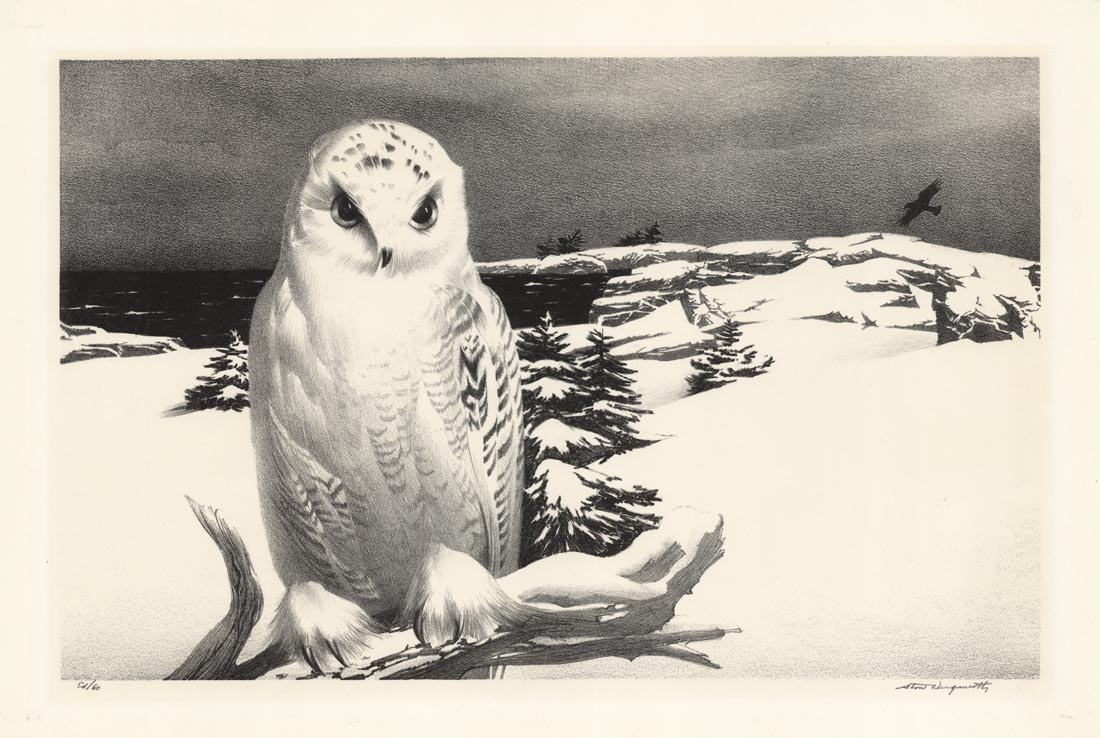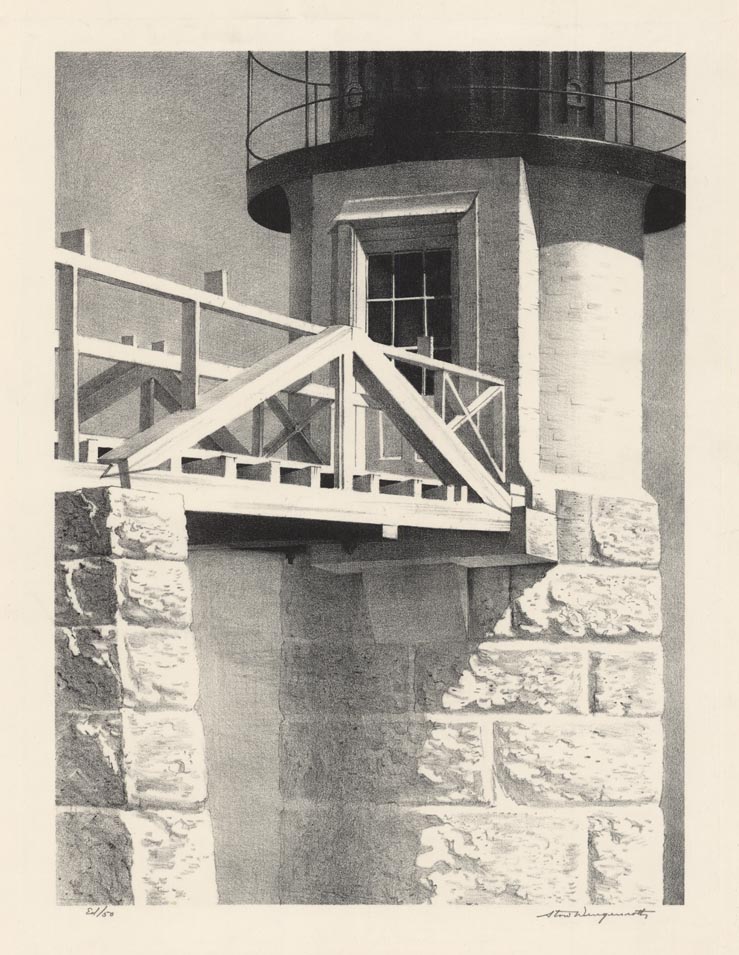 Winter Visitor. [Greenport, New York.] Lithograph, 1965.
Winter Visitor. [Greenport, New York.] Lithograph, 1965.
Stow Wengenroth (1906-1978) is well known for his wonderful images of New England, New York City, and Long Island. He was born in Brooklyn, New York, on July 25, 1906, to Frederick Wengenroth, an architect, and Isabelle Stow, a textile designer. He studied at the Art Students League in 1923 with George Bridgman, then at the Grand Central School of Art with Wyman Adams. During the summers in the 1920’s, he would go to Woodstock, New York, to work with John Carlson or to Eastport, Maine, and work with George Ennis. It was Ennis in 1929 who recommended that Wengenroth should think about  working in lithography.
working in lithography.
Wengenroth published his first lithographs in 1931, featuring the area in and around Eastport, Maine. His first one artist exhibition occured the same year at Macbeth Gallery.
Wengenroth used lithography as his primary form of artistic expression. His drawings at this time were almost all done using the drybrush technique. This is because drybrush drawings closely resemble how a lithograph will look when printed. When he found a drawing pleasing, he would walk from Brooklyn to George Miller’s studio in Manhattan and pick up a lithographic stone. He would then carry it to his studio to be worked. There he would interpret his drybrush drawings, which were always larger than the finished lithographs.
Because of the weight of the lithographic stones (many weighing 75 to 90 pounds), Wengenroth moved his studio into Manhattan to be closer to Miller's studio. For a while his studio was at 51 West Tenth Street. At the time, the building was occupied by many artists. His own studio had once been occupied by Winslow Homer.
Wengenroth faced a turning point in his life when he met and fell in love with a widow by the name of Edith Flack Ackley. Her late husband had been a jewlery designer, and was survived by Ackley and their daughter Telka. Ackley, a native of Greenport, Long Island, was also an artist. While she worked in painting, Ackley is mostly remembered for her dolls and books. She was the author of several publications, including Marionettes: Easy to Make! Fun to Use! and Dolls to Make for Fun and Profit, which her daughter illustrated. At the start of her relationship with Wengenroth, she was designing and making marionettes. The couple married in 1936.
By the time of their marriage, Wengenroth’s lithographs were popular with collectors; and he was represented by several galleries including Kennedy Galleries, Weyhe Gallery, Grand Central Art Galleries, and Goodspeeds Bookshop. Edith had several exhibitions of her marionettes at Macbeth Gallery.
Later in his life, Wengenroth stated that his wife was the most influential person in his work. She was an extra pair of eyes on every lithograph, she understood the creative struggle, and shared his love of art and nature. They spent many summers in Maine, nine in Port Clyde, one in Boothbay Harbor, one in Monhegan, one in Corea, one in Castine and several in Wiscasset. In the 1950’s they purchased a home in Greenport, Long Island, as did Wengenroth’s parents. However, they continued their travels in New England to create works.
Ackley suffered from arthritis in later years, and passed away in 1970. Wengenroth did a lithograph entitled Memory in her Honor. After her death, he spent more time in New England eventually settling in Rockport, Massachusetts, where he met Harriet Matson. They married in in 1974.
Wengenroth was a master at crayon lithography. He published books and articles on the subject of lithography, including Making a Lithograph in 1936 and numerous articles in the Print Collectors Quarterly. The majority of his lithographs are black and white. He printed a few in two colors, which have a grey background for atmosphere then black for the information. One has to look closely to even see the second color. He preferred his stones to have a bit of a grain, so they were not sanded smooth. He liked to use the stone's natural grain to his advantage when working.
Stow Wengenroth's lithographs are in most museums across the United States and many in Europe. Some have very large collections of his work. Two with large collections are the Boston Public Library and Brown University Library. These collections have extensive drybrush drawings and lithographs. His work is also in in the Brooklyn Museum, Carnegie Museum of Art, Cooper Hewitt, Metropolitan Museum of Art, Museum of Modern Art, New York Public Library, Peabody Essex Museum, Smithsonian American Art Museum, and Whitney Museum of American Art.
Wengenroth received many professional honors and awards. He was elected to the National Academy of Design in 1938 and the National Institute of Arts and Letters in 1942. He was a member of Albany Print Club, Audubon Artists, Prairie Printmakers, Printmakers Society of California, Rockport Art Association, Salmagundi Club, and the Society of American Graphic Artists.
Throughout his career Wengenroth produced 369 different lithographs and many more drybrush drawings. After his first wife passed away in 1970, he took up watercolor. He had not worked in watercolor since the 1920’s and produced a remarkable but small body of watercolors. Most were not signed by the artist.
He died on January 22, 1978 in Gloucester, Massachusetts.